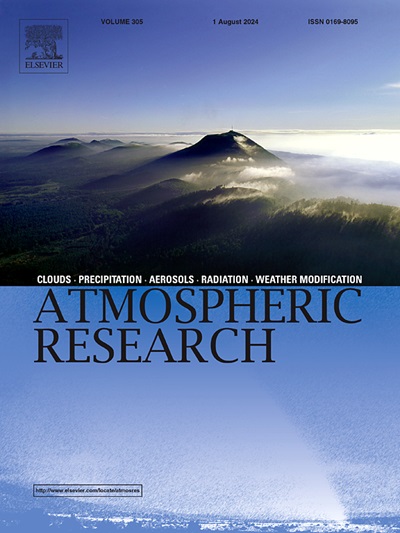Three-dimensional microphysical structure of the lower positive charge region in a thunderstorm: A case study for a supercell observed using dual-polarization radars
IF 4.5
2区 地球科学
Q1 METEOROLOGY & ATMOSPHERIC SCIENCES
引用次数: 0
Abstract
This study examines the three-dimensional (3D) microphysical and dynamical structure of the lower positive (LP) charge region within a normal tripole charge structure in a supercell thunderstorm that occurred over the Kanto Plain on August 27, 2018. The investigation utilizes hydrometeor classification and 3D wind retrieval data from dual-polarization radars, along with charge polarity classification data from a 3D lightning mapper. Key findings reveal that water-related hydrometeors (inferred as large raindrops, water-coated graupel, and/or water-coated hail) accounted for 52 % of the LP charges. Among these, water-coated hail exhibited a propensity for LP charging approximately 40 times greater than that of other hydrometeors, whereas graupel exhibited a propensity approximately 2.5 times greater. This suggests that radar-inferred graupel is not the most suitable proxy for LP charges in this event. LP charges were distributed from the bounded weak echo region associated with updrafts to the rear convergence zone. Liquid-water-related particles were more prevalent in the updraft region, while graupel and hail were more commonly observed in the downdraft. Based on these findings, the mechanisms underlying LP charge generation were elucidated. The presence of water-related particles in specific differential phase columns accompanying the updraft suggests that the shedding process may contribute to LP charge formation. This assumption aligns with previous hypotheses, supported by laboratory experiments, proposing that the removal of negatively charged liquid water from ice surfaces results in positive charging of ice particles. By correlating polarimetric radar variables with hydrometeor types and kinematic properties on a grid-by-grid basis, this study enhances our understanding of the 3D microphysical characteristics of the LP charge region and may provide important insights into lightning monitoring via radar observations.
本研究探讨了 2018 年 8 月 27 日发生在关东平原上空的一场超级大雷暴中,正常三极电荷结构内低正电荷(LP)区域的三维(3D)微物理和动力学结构。调查利用了双极化雷达的水文流星分类和三维风检索数据,以及三维闪电绘图仪的电荷极性分类数据。主要发现显示,与水有关的水流星(推断为大雨滴、水包冰雹和/或水包冰雹)占 LP 电荷的 52%。其中,水裹冰雹的低电压充电倾向约为其他水介质的 40 倍,而石榴石的充电倾向约为其他水介质的 2.5 倍。这表明,雷达推断的石榴石并不是此次事件中最适合的低电压电荷替代物。低压电荷分布在与上升气流相关的有界弱回波区和后部辐合区。与液态水有关的颗粒在上升气流区域更为常见,而在下降气流中则更多地观测到石榴石和冰雹。基于这些发现,我们阐明了低压电荷产生的机制。伴随上升气流出现在特定差相柱中的与水有关的颗粒表明,脱落过程可能有助于低压电荷的形成。这一假设与之前的假说一致,并得到了实验室实验的支持,假说认为冰表面带负电的液态水的脱落会导致冰颗粒带正电。通过将极坐标雷达变量与水文流星类型和运动特性逐格关联起来,这项研究加深了我们对 LP 电荷区域三维微物理特性的理解,并可能为通过雷达观测进行闪电监测提供重要启示。
本文章由计算机程序翻译,如有差异,请以英文原文为准。
求助全文
约1分钟内获得全文
求助全文
来源期刊

Atmospheric Research
地学-气象与大气科学
CiteScore
9.40
自引率
10.90%
发文量
460
审稿时长
47 days
期刊介绍:
The journal publishes scientific papers (research papers, review articles, letters and notes) dealing with the part of the atmosphere where meteorological events occur. Attention is given to all processes extending from the earth surface to the tropopause, but special emphasis continues to be devoted to the physics of clouds, mesoscale meteorology and air pollution, i.e. atmospheric aerosols; microphysical processes; cloud dynamics and thermodynamics; numerical simulation, climatology, climate change and weather modification.
 求助内容:
求助内容: 应助结果提醒方式:
应助结果提醒方式:


